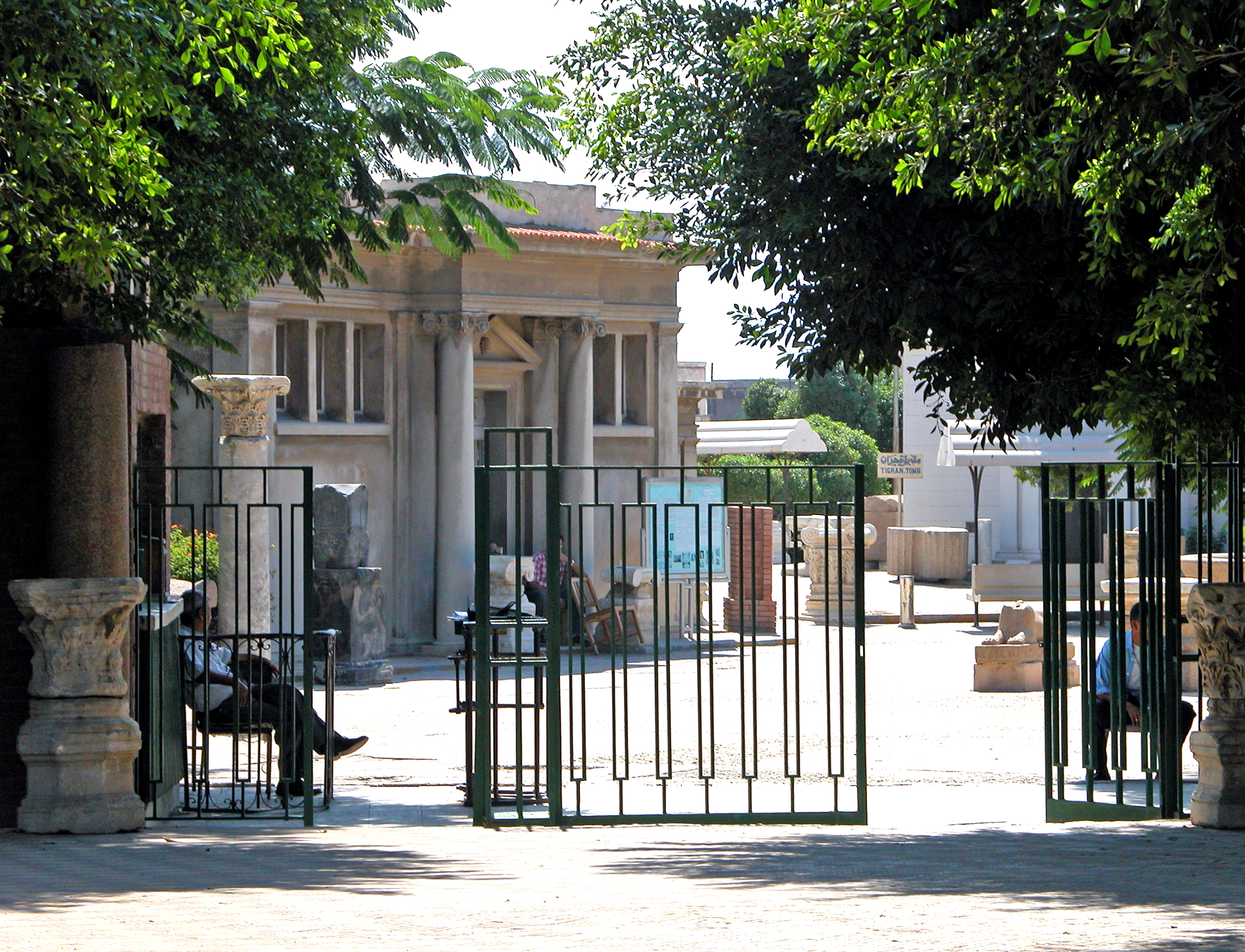The catacombs of Kom El Shukafa
The Catacombs of Kom El-shokafa which date from the second century A.D are unique both for their plan and for their decoration which is a mixture of Egyptian and Greco-Roman elements .
Excavations in the site started in 1892, but the catacombs were not found until 1900 when by mere chance the falling of a donkey drawing a cart in a pit led to their discovery.
The tomb consists of three stories cut in the rock, but the lower one gets filled with subsoil water and for this reason most of it has been filled with sand.
A staircase (A) goes round a large shaft, down which the dead
bodies used to be lowered by rops. The stair ends at the first floor with a vestibule (B) with a semi circular niche on each side. Each niche is fitted with a bench and roofed with a shell. This leads to a rotunda (C) with another large shaft in the middle surrounded by a parapet upon which stand eight pillars supporting the domed roof. At the bottom of the shaft were found five stone heads which were removed to the Museum (Hall 16) and casts of them were made and can be seen on the parapet.
To the left of the rotunda is the banquet hall (D) or triclinum, where relatives and friends of the dead could meet on special occasions .
Here are cut in the rock three large benches on which they could recline upon mattresses while eating. The tables have disappeared and were probably made of wood.
From the rotunda a staircase (E) leads down to the second storey, the main part of the tomb, which consists of a vestibule and a burial chamber. The vestibule(F) has two fine columns with floral capitals and two pilastere with capitals of papyrus and acanthus intermingle, the four support a cornice adorned with a winged solar disk between two falcons and with a kind of denticulated friez. Above the cornice 18 a law arched pediment decorated in the middle with the solar disk.
On both sides of the vestibule two niches in the shape of Egyptian door-ways are hewn in the rock with two statues lnelde, one of a woman (to the left) and the other one of a man (to the right). These two statues, except for the heads, were executed according to the rules of Egyptian art.
They are represented standing with one foot in advance to the other and with both hands stretche down on the sides. The woman in clad in a long tight dress which covers the body till just above the feet, while the man wears a kilt. The hair dress of them is typical Roman like those which date from the second century A.D.
In the middle of the wall at the back of the vestibule is a door surmounted by a cornice decorated with the winged sun disk and a frieze of urael (cobras). To the right and left of this door, on two pedestals in the form of an Egyptian naos, are two great serpents carved in the relief , wearing the double crown of Upper and Lower Egypt. Each of the two serpents has on one side the pine-cone (Hyrsus), symbol of Dionysus, and on the other the serpent- wand (caduceus), symbol of Hermes. These serpents seem to represent not only Agathodemons (l.e good genii) but also the serpents sacred to the Egyptian gods of the dead Osiris and Isis and to Hermes, the guide of dead in the other world according to Greek mythology. Above the head of each of these two serpents is a head of Medusa on a round shield, intended, no doubt, to frighten and keep the robbers away from the tomb.
The burial chamber(G) contains three large recesses on three sides. In each of them a sarcophagus is cut in the rock, complete with its lid. They closely resemble each other, and are decorated with festoons of flowers, masks and bulls-heads. The lids are not separate and bodies were entered from opening in the passage behind.
The back wall of the central sarcophagus shows a typical Egyptian scene of mummification; In the middle on a funerary-bed lies the mummy, while the jackal- headed Anubis, god of mummification, stands behind the bed with his right hand on mummy, while the left carries a vase. Underneath the bed are three canopic jars Intended to contain the viscera of the deceased, one has a cover in the shape of a flacon’s head, the second a human head, and the third an ape’s head.
At the head of the bed, which takes the shape of a lion`s head stands the lbis –headed Thoth, god of wisdom. He holds in his right-hand avase and in the left a scepter. At the foot of the bed stands the falcon headed god Horus, who holds in his right hand a sceptre and in the left hand a vase.
The reliefs on the sides represent, to the right a woman standing, with the sun-disk on her head, sign of deification, up lifting both her hands in the gesture of adoration in front of a priest with two feathers on his head.
He offers her a lotus hud and a cup with a n ewer. Between the two is an altar decorated with lotus flower. The scene to the left represents a man standing, holding something in his right hand and uplifting his left hand in adoration. In front of him stands a lector priest holding a roll of papyrus in both hands. Between the two is an altar decorated with lotus flowers.
On the back wall of the niche to the right we see the king standing, wearing the double crown of Upper and Lower Egypt and holding a necklace in both hands which he offers to the sacred bull represented standing on a pedestal with a goddess behind, probably Isis, protecting the bull with her two outstretched wing. The right side represents a mummy standing with the sun-disk on its head, holding a long staff with both hands. In front of it stands a jackal-headed god with the sun-disk on his head holding a long staff with both hands. Between the two is an altar with a vase on it.
On the other side, to the left the left, we see the king standing, wearing headdress with the sun-disk encircled by the sacred cobra. His right arm is stretched down to his side, while he offers a feather (symbol of truth)by his left hand to the god standing in front of him, This god, most probably being in the form of a mummy, is represented standing with the sun disk on his head, holding a scepter with both hands. Between the two is an altar adorned with lotus flowers.
The scene on the back of the niche on the left hand side is nearly the same as that on the right hand side.
It represents the king who offers a necklace to the sacred bull standing on a pedestal with a goddess behind protecting the bull with her outstretched wings. On the lateral side, to the right, is represented the king standing with the sun disk and cobra on his head holding a long staff with both hands. In front of him the Falcon headed god Horus stands wearing the double crown of Upper and Lower Egypt, holding a long staff with both hands. Between the two is an altar with a vase on it, on the lateral side to the left we see the king standing, wearing a kilt. He offers a feather with his right hand to a god standing in front of him. This god is represented in the shape of a mummy with the sun disk on its head. Between the two stands an altar adorned with flowers. On both sides of the entrance to this burial chamber, on the way out, we see on the right hand side the Egyptian Jakal-headed god Anubis in a military uniform. He is represented standing with the sun disk on his head, holding a long staff with his right hand. On the other side of the entrance, the same god is represented with the lower part of a dragon. These divinities are again a mixture of Egyptian and Greco-Roman form, which makes this tomb a unique example in its kind. Surrounding this part of the tomb are narrow passages with more than 300 loculi in two rows for burial (H), of which those in room (J.) were for the followers of goddess Nemesis. In one of the loculi was found the mummy of a priestess of this goddess with a golden chain round her neck, adorned with the wheel of this goddess and other thin leaves of gold which covered the eyes, the breast, the tongue, the mouth, and even the nails of fingers and toes. We now return to the rotunda (C), and enter, through a breach in the rock, to an entirely different set of tombs. These are lit by a square shaft at the bottom of which stands an altar. They could be reached directly from outside by a staircase hewn in the rock but it is now blocked. This part is called after the Emperor Caracalla because of the bones which were found in it and which were believed to have been the result of the massacre which happened during his visit to Alexandria . But the bones found there belong more to animals, and specially horses, than to human beings. As this part of the tomb was dedicated to Nemesis. Goddess of sports , it is thought that horses which won in races were honoured after their death and buried here under the protection of the goddess.
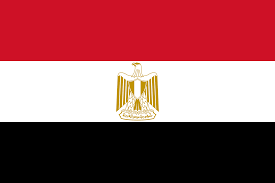

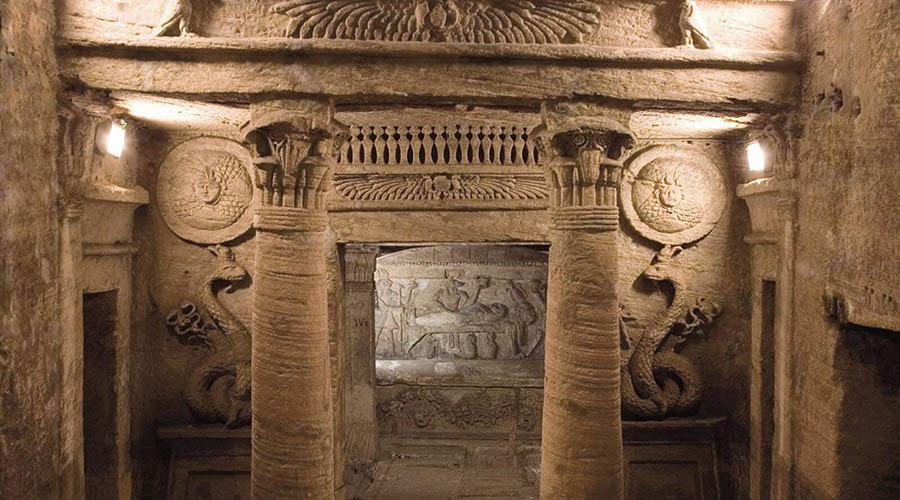
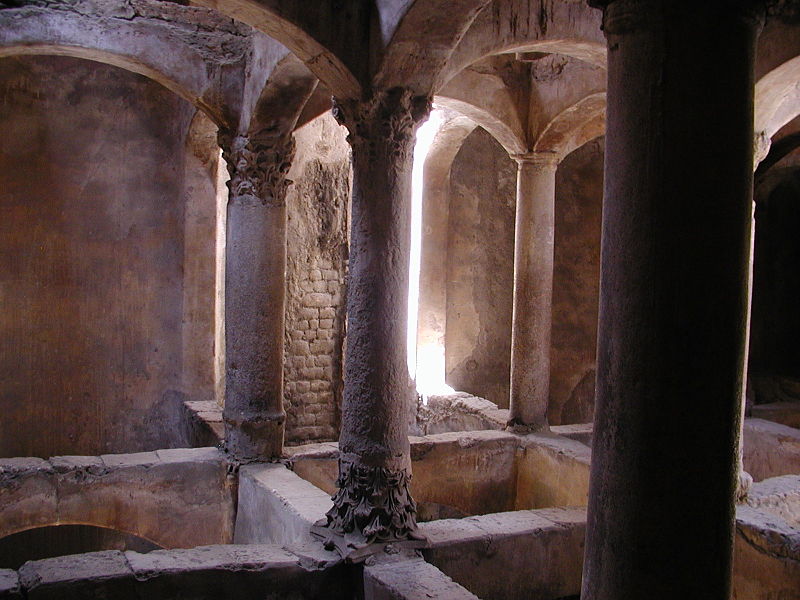




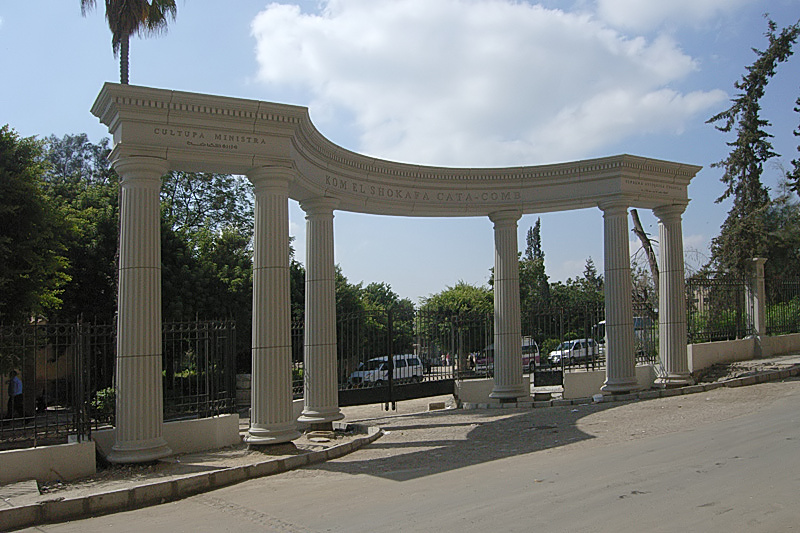
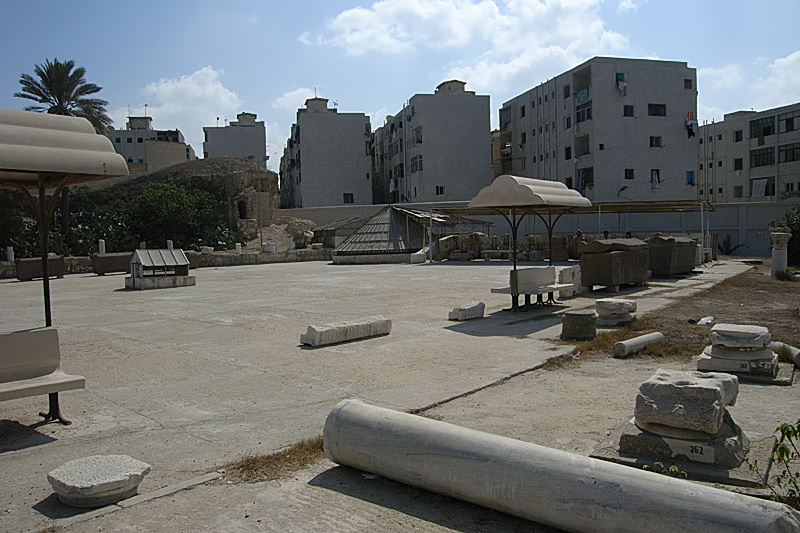
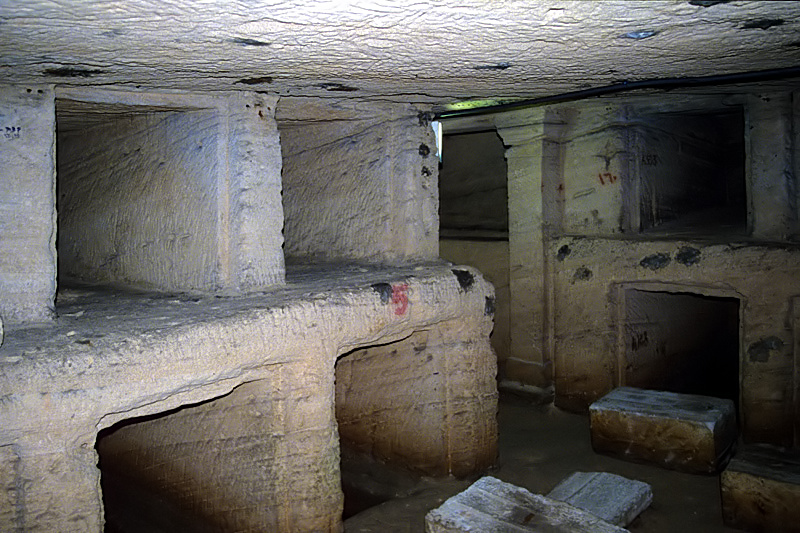
_-_TIMEA.jpg)
